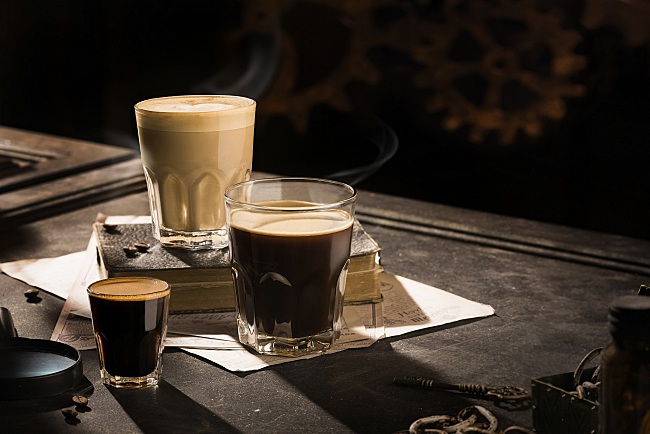Comprehending Coffee Beans: the Journey From Coffee to Blended Coffee Beans

The Origins of Coffee: An International Viewpoint
While you may think of coffee as a modern-day staple, its origins map back centuries, intertwining with societies throughout the globe. The tale begins in Ethiopia, where tale says a goat herdsman called Kaldi uncovered the stimulating effects of coffee beans after seeing his goats frolicking energetically after eating them.
As profession courses increased, coffee made its way to Europe in the 17th century, quickly gaining popularity. It changed from a magical drink right into an everyday ritual, intellectual exchanges and motivating celebrations. Each culture added its one-of-a-kind twist to coffee prep work, enriching its history. This worldwide trip highlights how coffee links us, going beyond borders and unifying varied practices through a straightforward bean.
Growing and Harvesting of Espresso Beans
As coffee's journey progressed, the emphasis moved to the growing and harvesting of certain bean ranges, especially those utilized for espresso. You'll find that espresso beans frequently come from Arabica or Robusta plants, each offering distinct flavors. The suitable expanding problems include high elevations and abundant, well-drained dirt, which enhance the beans' quality.
Throughout the harvest, choosing methods differ. Timing is crucial; you want to harvest when the cherries get to peak ripeness for optimum taste.
When gathered, the beans are prepared for handling, which is necessary in identifying their final preference. Comprehending the growing and gathering procedures provides you insight right into what goes into your preferred espresso, enriching your admiration for every cup.
Processing Techniques: From Cherry to Bean
Now that you have actually learnt more about harvesting espresso beans, allow's check out exactly how those cherries transform into the coffee beans you enjoy. You'll see exactly how various harvesting techniques effect taste, complied with by the important actions of fermentation and drying out. Lastly, we'll damage down the milling and grading process that identifies your coffee's top quality.
Collecting Techniques Described
When it comes to coffee, recognizing harvesting techniques is vital, since they directly impact the flavor and quality of the beans you take pleasure in. Discerning selecting entails hand-picking only ripe cherries, ensuring you obtain the best quality beans. Eventually, the choice of harvesting strategy can considerably affect your coffee experience, so it's worth understanding how those beans made it to your mug.
Fermentation and Drying Out
After collecting, the next steps in processing coffee beans play a significant duty in forming their flavor. You'll locate that fermentation is essential, as it aids damage down the mucilage bordering the beans, improving their preference profile. Depending upon the method, this process can last from a few hours to several days, with differing results based upon temperature level and humidity.
Once fermentation is complete, drying follows, which is just as vital. You can pick from mechanical or sun-drying drying out techniques. Sun-drying permits the beans to take in flavors from the environment, while mechanical drying out warranties constant wetness levels no matter weather condition. Proper drying out is vital to avoid mold and mildew and preserve the beans' high quality, ultimately affecting your cup of coffee.
Milling and Grading Refine
As fermentation and drying out set the stage for taste development, the milling and grading process assurances that only the best coffee beans make it to your cup. This stage involves removing the outer layers of the coffee cherry, consisting of the parchment and husk. Top quality beans get a greater grade, resulting in a richer coffee experience.
Toasting Methods: Unlocking Flavor Potential
When you roast coffee beans, the approach you pick can considerably influence the taste account. Understanding the connection between time, temperature, and roasting techniques is key to disclosing the possibility of your brew. Let's explore how these components collaborated to develop the excellent mug.
Toasting Approaches Clarified
While you could assume that all coffee toasting approaches yield the very same outcomes, the truth is that each technique exposes special taste capacities in the beans. Drum toasting uses a revolving drum to evenly distribute warmth, enhancing caramelization and creating a well balanced flavor. Air roasting, on the other hand, flows hot air around the beans, advertising a lighter roast with obvious acidity.

Influence On Taste Profile
Various toasting methods not only affect the procedure but likewise greatly impact the taste account of the coffee beans. When you choose a light roast, you'll experience bright level of acidity and flower notes, showcasing the bean's beginning. On the other hand, a medium roast balances level of acidity with sweet taste, commonly revealing chocolatey undertones. Dark roasts, on the various other hand, highlight bold, great smoky tastes, sometimes concealing the bean's special qualities. Each strategy reveals various oils and substances, leading to a vast array of flavors. By explore numerous roasting styles, you can discover which profiles resonate with your palate. Comprehending these nuances helps you appreciate the creativity behind your mug of coffee, improving your total experience with every sip.
Time and Temperature Aspects
To release the full flavor capacity of coffee beans, both time and temperature during the roasting process play significant roles. When toasting, you'll find that greater temperature levels can promptly create flavors, however if you rush it, you could finish up with scorched notes. right here Conversely, lower temperature levels permit a much more progressive taste growth, showcasing the beans' one-of-a-kind qualities.

Timing is simply as vital; expanding the roast also long can lead to a loss of acidity and illumination, while too brief a roast visite site may leave the beans underdeveloped. Locating that pleasant place needs practice and experimentation. By adjusting these factors, you can reveal the rich, intricate flavors hidden within each bean, creating a truly impressive coffee experience.
The Art of Blending: Crafting One-of-a-kind Coffee Accounts

Begin by picking a base coffee that offers a strong structure. Choose complementary beans to boost specific flavor notes. An intense Ethiopian bean can bring fruitiness, while an abundant Brazilian coffee adds body. Trial and error is essential-- do not hesitate to readjust proportions until you discover your ideal profile.
As you blend, keep in mind that each combination narrates. You're not just making coffee; you're producing an experience. Take your time, preference regularly, and enjoy the journey of discovering your signature mix - Single Origin Espresso.
Developing Approaches: Just How Prep Work Influences Taste
Blending coffee opens up a domain of taste possibilities, yet exactly how you brew that mix can significantly affect your final cup. On the various other hand, a pour-over highlights the see coffee's clarity and illumination, ideal for showcasing delicate notes.
Espresso, with its high stress, creates a concentrated shot that accentuates sweet taste and crema. If you like a lighter mixture, take into consideration a chilly brew method; it yields a smooth, much less acidic preference.
Inevitably, trial and error is essential. Changing variables like water temperature, grind dimension, and brew time can transform your coffee's account. Accept the art of brewing to discover the tastes hidden in your coffee blends. The right method can elevate your experience to new elevations.
The Future of Coffee: Sustainability and Technology
As the coffee industry advances, sustainability and innovation are coming to be crucial for resolving environmental challenges and conference customer needs. You'll notice that even more coffee business are adopting environment-friendly practices, from sourcing beans morally to executing lasting farming techniques. These shifts not just aid the planet yet also boost the high quality of the coffee you enjoy.
You may see innovations like eco-friendly packaging and water-saving brewing approaches that decrease waste. Advanced innovation, such as blockchain, is likewise coming to be preferred, ensuring transparency in the supply chain, which allows you to map your coffee back to its origins.
Furthermore, purchasing regional neighborhoods and supporting farmers with fair trade initiatives fosters a more sustainable coffee community. As you sip your next cup, bear in mind that your choices can add to a brighter future for coffee. By choosing for sustainable brands, you're not just delighting in a beverage; you're making a positive effect on the world.
Frequently Asked Questions
What Is the Distinction Between Arabica and Robusta Beans?
Arabica beans are smoother, sweeter, and have a higher acidity, while robusta beans are more powerful, a lot more bitter, and include more high levels of caffeine. When making your coffee., you'll observe these differences in taste and fragrance.
How Does Elevation Affect Coffee Bean Taste?
Altitude influences coffee bean flavor considerably. Greater elevations produce beans with brighter level of acidity and complex tastes, while lower elevations typically yield beans that are larger and less nuanced. You'll see these differences in your mug!
What Are the Health And Wellness Benefits of Alcohol Consumption Coffee?
Drinking coffee can boost your energy, improve psychological emphasis, and even boost physical efficiency. It's rich in anti-oxidants, may decrease the danger of certain diseases, and can advertise a healthier metabolic rate when consumed in small amounts.
Can Coffee Beans Be Reused for Developing?
Yes, you can reuse coffee beans for developing, however the taste might be weaker. If you appreciate exploring, attempt reusing them in various ways, like chilly mixtures or including in healthy smoothies for an added kick.
How Should I Shop Coffee Beans for Freshness?
To keep your coffee beans fresh, keep them in a closed container in a great, dark place. Avoid subjecting them to light, wetness, or warm, as these elements can swiftly weaken their taste and fragrance.
Understanding Coffee Beans: the Journey From Espresso to Blended Coffee Beans.
Now that you've discovered regarding collecting coffee beans, allow's discover just how those cherries change right into the coffee beans you love.When you roast coffee beans, the method you choose can considerably influence the taste account - Single Origin Espresso.While you could assume that all coffee toasting approaches generate the exact same outcomes, the reality is that each method exposes special taste capacities in the beans.Different roasting methods not only affect the procedure but also significantly impact the taste account of the coffee beans